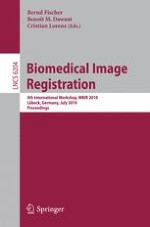Welcome to the proceedings of the 4th Workshop on Biomedical Image R- istration (WBIR). Previous WBIRs took place in Bled, Slovenia (1999), at the UniversityofPennsylvania,USA(2003)andinUtrecht,TheNetherlands(2006). This year, WBIR was hosted by the Institute Mathematics and Image Proce- ing and the Fraunhofer Project Group on Image Registration and it was held in Lub ¨ eck, Germany. It provided the opportunity to bring together researchers from all over the world to discuss some of the most recent advances in image registration and its applications. We had an excellent collection of papers that were reviewed by at least three reviewers each from a 35-member Program Committee assembled from a wor- wide community of registration experts. This year 17 papers were accepted for oral presentation, while another 7 papers were accepted as poster papers. We believe all of the conference papers were of excellent quality. Registration is a fundamental task in image processing used to match two or more pictures taken, for example, at di?erent times, from di?erent sensors, or from di?erent viewpoints. Establishing the correspondence of structures within medical images is fundamental to diagnosis, treatment planning, and surgical guidance. The conference papers address state-of-the-art techniques for prov- ing reliable and e?cient registration techniques, thereby imposing relationships between speci?c application areas and appropriate registration schemes. We are grateful to all those who contributed to the success of WBIR 2010.
